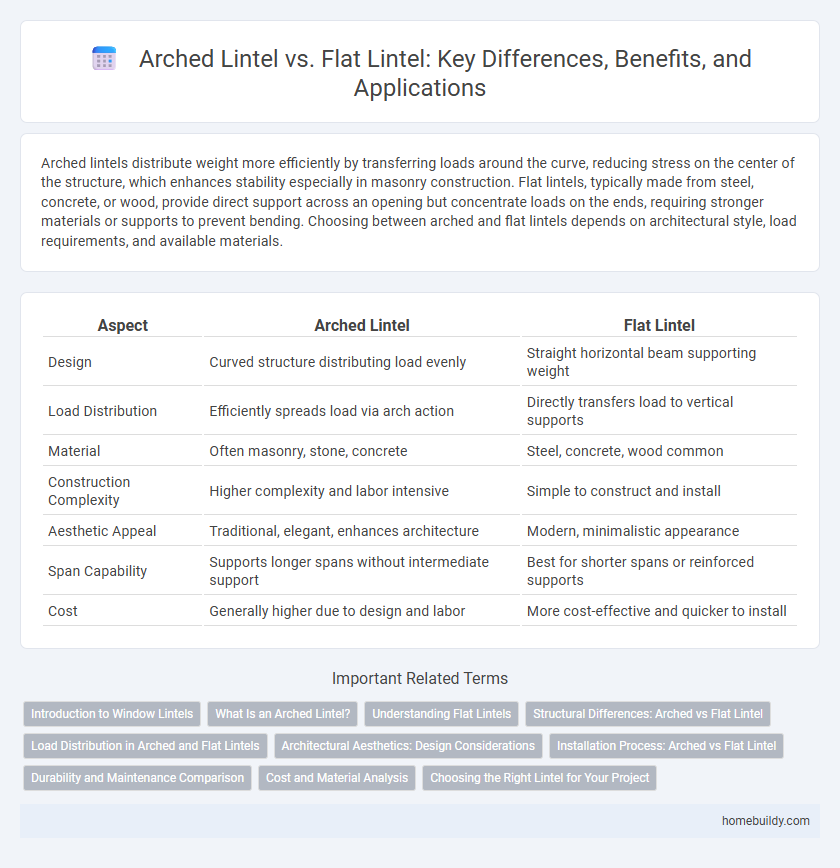Arched lintels distribute weight more efficiently by transferring loads around the curve, reducing stress on the center of the structure, which enhances stability especially in masonry construction. Flat lintels, typically made from steel, concrete, or wood, provide direct support across an opening but concentrate loads on the ends, requiring stronger materials or supports to prevent bending. Choosing between arched and flat lintels depends on architectural style, load requirements, and available materials.
Table of Comparison
| Aspect | Arched Lintel | Flat Lintel |
|---|---|---|
| Design | Curved structure distributing load evenly | Straight horizontal beam supporting weight |
| Load Distribution | Efficiently spreads load via arch action | Directly transfers load to vertical supports |
| Material | Often masonry, stone, concrete | Steel, concrete, wood common |
| Construction Complexity | Higher complexity and labor intensive | Simple to construct and install |
| Aesthetic Appeal | Traditional, elegant, enhances architecture | Modern, minimalistic appearance |
| Span Capability | Supports longer spans without intermediate support | Best for shorter spans or reinforced supports |
| Cost | Generally higher due to design and labor | More cost-effective and quicker to install |
Introduction to Window Lintels
Window lintels serve as critical structural components that support the load above window openings. Arched lintels distribute weight through a curved design, offering enhanced strength and aesthetic appeal, while flat lintels provide straightforward, horizontal support typically used in modern constructions. Choosing between arched and flat lintels depends on factors such as architectural style, load requirements, and material availability.
What Is an Arched Lintel?
An arched lintel is a curved structural element placed above doors or windows, designed to distribute weight more efficiently than a flat lintel. Typically constructed from materials like stone, brick, or reinforced concrete, its curved shape directs the load along the arch to the supporting walls or columns. This design enhances stability and adds aesthetic appeal in architectural applications compared to the straight, horizontal form of a flat lintel.
Understanding Flat Lintels
Flat lintels are structural horizontal supports typically made from reinforced concrete, steel, or timber, designed to bear loads above window and door openings without altering the wall's visual continuity. Unlike arched lintels, flat lintels distribute weight directly across a linear span, making them ideal for modern, minimalist architectural styles where clean lines and simplicity are prioritized. Their straightforward installation and cost-effectiveness make flat lintels a common choice in both residential and commercial construction projects.
Structural Differences: Arched vs Flat Lintel
Arched lintels distribute loads through compression along the curve, effectively transferring weight to the supports and reducing bending stress. Flat lintels primarily resist bending forces and shear stress, requiring stronger materials such as reinforced concrete or steel to span openings. The arch's shape naturally channels forces downward, while flat lintels rely on material strength and reinforcement to maintain structural integrity.
Load Distribution in Arched and Flat Lintels
Arched lintels distribute load more efficiently by transferring weight laterally to the supports, reducing bending stress and enhancing structural stability. Flat lintels bear loads directly above, subjecting the material to higher bending moments and requiring stronger reinforcement to prevent failure. The curved shape of arched lintels allows for improved load-bearing capacity in masonry and stone construction compared to flat lintels.
Architectural Aesthetics: Design Considerations
Arched lintels offer enhanced architectural aesthetics by introducing graceful curves that complement classical and traditional designs, while flat lintels provide a clean, minimalist appearance suited for modern and contemporary structures. The choice between arched and flat lintels significantly influences the visual character of a building's facade, impacting both style coherence and spatial perception. Material selection and structural requirements further guide design considerations, ensuring the lintel's form aligns with aesthetic goals without compromising load-bearing functionality.
Installation Process: Arched vs Flat Lintel
Arched lintels require precise shaping and support during installation to ensure even load distribution, often involving temporary centering frameworks to maintain the curve until the mortar sets. Flat lintels are generally easier and quicker to install, relying on straightforward placement across the opening with adequate bearing on both sides to transfer loads. The complexity of arched lintel installation demands skilled labor and meticulous alignment compared to the more straightforward process for flat lintels.
Durability and Maintenance Comparison
Arched lintels distribute weight more efficiently across the structure, enhancing durability by reducing stress concentrations compared to flat lintels, which can be more prone to cracking under heavy loads. Maintenance for arched lintels is often lower because their curved shape minimizes water pooling and related damage, whereas flat lintels may require more frequent inspection and sealing to prevent water infiltration and deterioration. Material choice and construction quality also influence the lifespan of both lintel types, but arched lintels inherently offer greater resilience in load-bearing applications.
Cost and Material Analysis
Arched lintels typically require more intricate craftsmanship and curved formwork, resulting in higher labor and material costs compared to flat lintels. Flat lintels commonly use precast concrete or steel, offering economical mass production and straightforward installation. Material selection influences durability and load-bearing capacity, with arched lintels often utilizing stronger masonry to distribute loads efficiently, increasing initial investment but reducing long-term maintenance expenses.
Choosing the Right Lintel for Your Project
Arched lintels distribute load more effectively, providing enhanced structural support for wider openings while adding aesthetic value to traditional or classical designs. Flat lintels are simpler to construct, cost-effective, and ideal for modern architecture with straight lines and smaller spans. Selecting the right lintel depends on factors such as load-bearing requirements, architectural style, budget constraints, and the width of the opening.
arched lintel vs flat lintel Infographic

 homebuildy.com
homebuildy.com